Comic Strip Spread

Difficulty: Easy
Note: This spread works best with decks like the Diary of a Broken Soul or Surrealist Tarot because they display scenes rather than pips and do not use reversals.
The Comic Strip Spread is a simple nine-card chronological spread that looks like a page of a comic book. This method should be used to get a glimpse of the future as it would pan out naturally. It may be insightful to use this spread in coordination with biorhythms. The spread is easy to read as a storyboard, just like a comic strip.
The main subject is apparent in the first card, while the story plays out through the following tarot cards.
It is important to pay particular attention to the cards and the relationships with their neighbours. Notice which directions the cards are facing, and how they interact.
Your Comic Strip Reading
Valet of Coins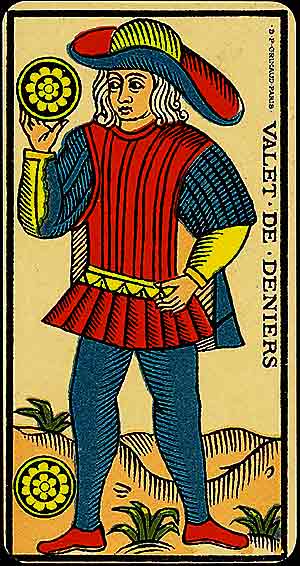 |
Ten of Swords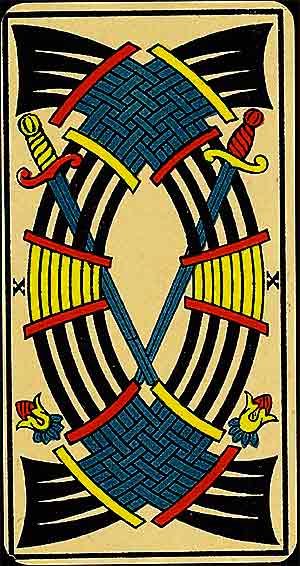 |
Six of Swords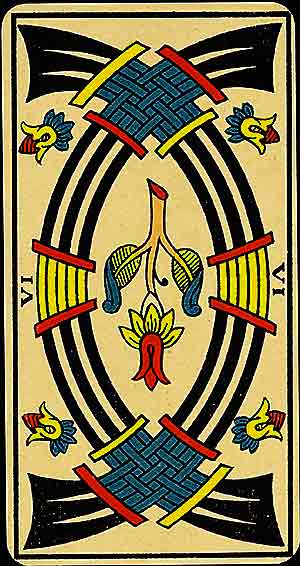 |
XVIII – The Moon (La Lune)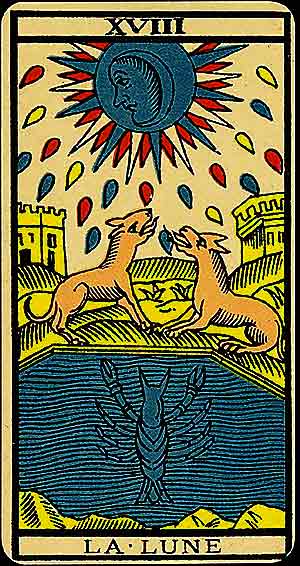 |
XX – Judgement (Le Jugement)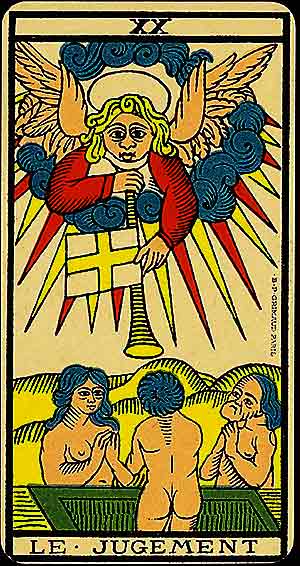 |
XIII – Death (La Mort)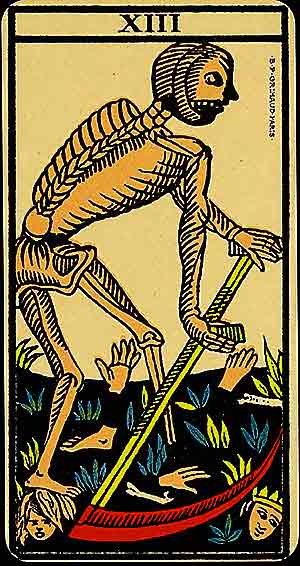 |
VIII – Justice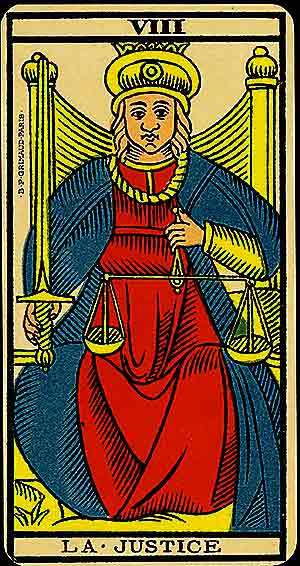 |
Four of Swords |
Nine of Coins |

Card 1: Valet of Coins
The Valet of Coins represents curiosity, learning, and the exploration of material opportunities. It reflects a novice's energy, focused on growth and the potential for prosperity.
Symbolism: The Valet stands holding a single coin, examining it attentively. His simple yet fancy attire reflects his connection to practicality and his aspiration towards refinement. His stance suggests openness to new possibilities and a willingness to learn from experience.
In Relationships: A budding relationship or a fresh perspective on an existing one. It may indicate someone earnest and dependable but inexperienced in emotional matters.
In Work: The beginning of a new project, study, or skill development. This card encourages patience and diligence in pursuing goals.
Spiritually: The Valet invites you to ground yourself in practical wisdom while exploring your spiritual path.
When ill-dignified: Procrastination, immaturity, or lack of focus. It warns against undervaluing opportunities or avoiding responsibility.

Card 2: Ten of Swords
The Ten of Swords signifies endings, collapse, and the release of what no longer serves. While it represents a painful conclusion, it also promises renewal and the possibility of a fresh start.
Symbolism: Ten swords form a heavy, intertwined pattern, with minimal room for growth. The design emphasises finality and the weight of a tough cycle ending.
In Relationships: The conclusion of a relationship or the need to accept closure for emotional healing.
In Work: The end of a challenging phase, making way for new opportunities. Letting go of old methods is crucial.
Spiritually: The card symbolises surrender and transformation, urging the seeker to embrace the cycles of death and rebirth.
When ill-dignified: Resistance to closure, unnecessary suffering, or refusal to move on. It warns against clinging to what has already ended.

Card 3: Six of Swords
The Six of Swords represents transition, recovery, and the journey towards calmer waters. It is a card of progress through reflection and leaving behind what no longer serves.
Symbolism: Six curved swords are arranged in an oval pattern, suggesting motion and harmony. The floral motifs emphasise renewal and the promise of growth through change.
In Relationships: Moving forward together after difficulties, or the need to let go of a relationship for emotional peace.
In Work: Transitioning to a new role or project. It reflects progress and adaptability in the face of challenges.
Spiritually: The card invites the seeker to release burdens and embrace the journey towards enlightenment.
When ill-dignified: Resistance to change, stagnation, or clinging to the past. It warns against avoiding necessary transitions.

Card 4: XVIII – The Moon (La Lune)
The Moon symbolises intuition, mystery, and the subconscious. It reflects the realm of dreams, illusions, and emotions, inviting you to explore the depths of your psyche and confront hidden truths.
Symbolism: The Moon casts its dim light over a mysterious scene: a dog and a wolf howl beneath its glow, representing the duality of tame and wild instincts. A crayfish emerges from the water, symbolising the hidden depths of the subconscious rising to the surface. The two towers suggest boundaries between reality and the unknown.
In Relationships: Emotional complexity, hidden dynamics, or the need to trust your intuition. Beware of illusions or misunderstandings.
In Work: A period of uncertainty or unclear direction. It encourages careful reflection and trusting inner instincts over external noise.
Spiritually: The Moon calls for introspection and exploration of the shadow self through dreams, intuition, and subconscious symbols.
When ill-dignified: Confusion, deception, or fear of the unknown. It warns against being lost in illusions or succumbing to anxiety.

Card 5: XX – Judgement (Le Jugement)
Judgement signifies awakening, transformation, and the call to a higher purpose. It represents a time of reckoning and renewal, offering the opportunity to align with divine will and embrace rebirth.
Symbolism: An angel blows a trumpet from above, awakening figures rising from coffins below. The trumpet symbolises divine calling, while the figures' praying hands reflect surrender and readiness for transformation. The scene suggests liberation and the promise of a new phase of existence.
In Relationships: Healing, forgiveness, or a transformative phase. It may signify a second chance or a fresh start.
In Work: A moment of clarity or a major decision that aligns your work with your higher purpose. Renewal is on the horizon.
Spiritually: Judgement calls you to awaken to your true calling, embrace forgiveness, and prepare for a spiritual rebirth.
When ill-dignified: Resistance to change, self-doubt, or avoidance of accountability. It warns against ignoring the call to transform.

Card 6: XIII – Death (La Mort)
Death signifies transformation, endings, and renewal. While often feared, this card speaks to the cyclical nature of life and the necessity of clearing away the old to make way for the new.
Symbolism: A skeletal figure wields a scythe, cutting through the remnants of the past—hands, heads, and plants alike. The barren ground reflects the stripping away of what no longer serves, while the sprouting flowers hint at rebirth and growth emerging from decay.
In Relationships: The end of a relationship or a transformative phase within one. It signals profound changes, often for the better.
In Work: A major shift, such as the end of a job or the restructuring of goals. It's a call to embrace new opportunities.
Spiritually: Death teaches the power of release and the necessity of embracing life's cycles to achieve transformation.
When ill-dignified: Fear of change, stagnation, or clinging to the past. It warns against resisting the natural process of renewal.

Card 7: VIII – Justice
Justice signifies truth, balance, and the law of cause and effect. She represents the impartial hand of the universe, delivering outcomes that align with one's actions and intentions.
Symbolism: Seated on a throne, Justice holds scales in one hand and a sword in the other. The scales symbolise balance and fairness, while the sword represents the clarity and decisiveness required to enact justice. Her direct gaze emphasises accountability and integrity.
In Relationships: Honest communication and equitable partnerships. It calls for evaluating the fairness and balance within relationships.
In Work: Decisions made with integrity will lead to just rewards. It is a time to act ethically and weigh all options carefully.
Spiritually: Justice reflects the law of karma and encourages alignment with higher principles to achieve spiritual clarity.
When ill-dignified: Corruption, dishonesty, or imbalance. It warns against biased decisions or failure to take responsibility for your actions.

Card 8: Four of Swords
The Four of Swords symbolises rest, recuperation, and mental clarity achieved through stillness. It reflects the need for pause before taking further action.
Symbolism: Four curved swords form an oval frame, with interwoven bindings at the top and bottom, creating a sense of structure and containment. At the centre of the composition, a single blooming flower emerges, symbolising peace, recovery, and renewal. The flowing curves and woven intersections suggest a more organic approach to rest and contemplation. The imagery highlights the importance of finding harmony within stillness, reinforcing the idea that mental clarity arises when balance and inner peace are embraced.
In Relationships: A period of emotional detachment or taking space to reflect on a relationship's direction.
In Work: A time for rest or strategic planning. Progress will come after regrouping and gathering strength.
Spiritually: The card invites retreat into meditation or introspection to realign with higher truths.
When ill-dignified: Stagnation, resistance to rest, or avoidance of necessary reflection. It warns against burnout or neglecting self-care.

Card 9: Nine of Coins
The Nine of Coins signifies independence, self-sufficiency, and the enjoyment of material and personal success. It reflects the rewards of hard work and discipline.
Symbolism: Nine coins are arranged in a flourishing design, surrounded by decorative elements that evoke luxury and abundance. The card's richness emphasises comfort and personal fulfilment.
In Relationships: A stable and independent relationship or a time of personal fulfilment before pursuing a partnership.
In Work: Success achieved through your own efforts. It highlights financial stability and personal satisfaction.
Spiritually: The card reflects the contentment of being in harmony with your inner and outer worlds.
When ill-dignified: Overindulgence, isolation, or neglecting connections in favour of material pursuits. It warns against taking success for granted.